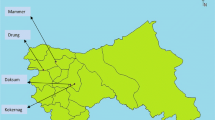Abstract
Four heavy-metal-tolerant isolates of ectomycorrhizal fungi namely Laccaria fraterna (Cooke & Massee) Pegler (EM-1083) and Pisolithus tinctorius (Mich. Ex Pers) Coker & Couch (EM-1290, EM-1293 and EM-1299) were selected on the basis of the previously performed experiments. DNA extraction and purification was done by following standard protocols. Subsequently, polymerase chain reaction (PCR) amplification of the ITS region was done using universal primer ITS 1 and ITS 4. The amplicons were digested with HinfI. The prominent band of the restricted fragments was excised and purified using geneEXIT™. Cloning and sequencing of the excised fragment was done following the standard method. Primers were designed with sequence information using the Gene Fisher Interactive PCR Primer design software. Amplification was successfully obtained using the designed primers in Pisolithus tinctorius (EM-1293). The size of the amplicon was 200 bp.

Similar content being viewed by others
References
Brown MT, Wilkins DA (1985) Zinc tolerance of Amanita and Paxillus. Trans Br Mycol Soc 84:367–369
Bruns TD, White TJ, Taylor JW (1991) Fungal molecular systematics. Annu Rev Ecol Syst 22:525–564
Colpaert JV, Vanassche JA (1993) The effects of cadmium on ectomycorrhizal Pinus sylvestris L. New Phytol 123:325–333
Dixon RK, Buschena CA (1988) Response of ectomycorrhizal Pinus banksiana and Picea glauca to heavy metals in soil. Plant Soil 105:256–271
Dueck TA, Visser P, Ernst WHO, Schat H (1986) Vesicular arbuscular mycorrhizae decrease zinc-toxicity to grasses growing in zinc-polluted soil. Soil Biol Biochem 18:331–333
Gardes M, Bruns TD (1993) ITS primers for enhanced specificity for basidiomycetes: application to the identification of mycorrhizae and rust. Mol Ecol 2:113–118
Gildon A, Tinker PB (1983) Interactions of vesicular-arbuscular mycorrhizal infection and heavy metals in plants. 1. The effects of heavy metals on the development of vesicular-arbuscular mycorrhizas. New Phytol 95:247–261
Jones MD, Dainty JD, Hutchinson TC (1988) The effect of infection by Lactarius rufus or Scleroderma flavidum on the uptake of 63Ni by paper birch. Can J Bot 66:934–940
Jones MD, Hutchinson TC (1986) The effect of mycorrhizal Infection on the response of Betula papyrifera to nickel and copper. New Phytol 102:429–442
Jurgens G, Glockner FO, Amann R et al (2000) Identification of novel Archaea in bacterioplankton of boreal forest lake by phylogenetic analysis and fluorescent in situ hybridization. FEMS Microbiol Ecol 34:45–56
Le Tacon F, Alvarez IF, Bouchard D et al (1992) Variations in field response of forest trees to nursery ectomycorrhizal inoculation in Europe In: Read DJ, Lewis D, Fitter A, Alexander I (eds) Mycorrhizas in ecosystems. CAB International, Wallington, UK, pp 119–134
Leyval C, Haselwandter K, Tarnau K (1997) Effect of heavy metal pollution on mycorrhizal colonization and function: Physiological ecological and applied aspects. Mycorrhiza 7:139–153
Marchner H, Dell B (1994) Nutrient uptake in mycorrhizal symbiosis. Plant Soil 159:89–102
Marx DH (1969) The influence of ectotrophic mycorrhizal fungi on the resistance of pine roots to pathogenic interactions. An antagonism of mycorrhizal fungi and soil bacteria. Phytopathology 59:153–163
Pace NR (1997) A molecular view of microbial diversity and the biosphere. Science 276:735–740
Ray P, Reddy UG, Lapeyrie F, Adholeya A (2005b) Effect of coal ash on growth and metal uptake by some selected ectomycorrhizal fungi in vitro. Int J Phytoremed 7:199–216
Ray P, Tiwari R, Reddy UG, Adholeya A (2005) Detecting the heavy metal tolerance level in ectomycorrhizal fungi in vitro. World J Microbiol Biotechnol 21:309–315
Tam PCF (1995) Heavy metal tolerance by ectomycorrhizal fungi and metal amelioration by Pisolithus tinctorius. Mycorrhiza 5:181–187
Turner AP (1994) The response of plants to heavy metals. In: Ross SM (ed) Toxic metals in soil plant systems. Wiley, Chichester, UK
Wilkinson DM, Dickinson NM (1995) Metal resistance in trees: the role of mycorrhizae. Oikos 72:298–300
Acknowledgments
The present study was supported by the Indo French Centre for the Promotion of Advanced Research (IFCPAR), project No. 2109–1. The authors wish to thank Dr. R.K. Pachauri, Director General, The Energy and Resources Institute, India, for providing the infrastructure facilities.
Author information
Authors and Affiliations
Corresponding author
Rights and permissions
About this article
Cite this article
Ray, P., Adholeya, A. Development of Molecular Markers of Ectomycorrhizal Fungi Based on ITS Region. Curr Microbiol 57, 23–26 (2008). https://doi.org/10.1007/s00284-008-9146-4
Received:
Accepted:
Published:
Issue Date:
DOI: https://doi.org/10.1007/s00284-008-9146-4




